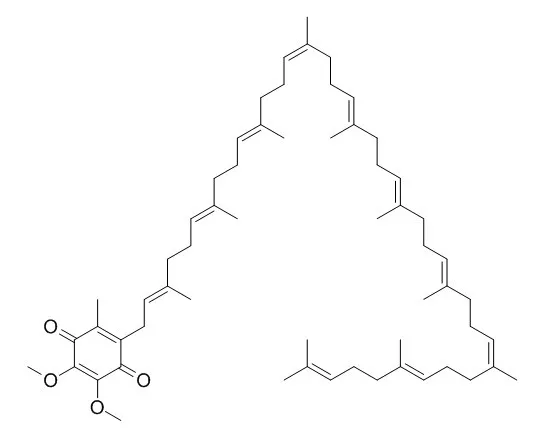| Description: |
Coenzyme Q10, an essential cofactor of the electron transport chain, has neuroprotective effect in the cerebral ischemia via as a potent antioxidant and oxygen derived free radicals scavenger. Treatment with coenzyme Q10 in patients with myocardial infarction (MI) may be beneficial in patients with high risk of atherothrombosis. The coenzyme Q10 and alpha-lipoic acid supplementation can improve bladder function after outlet obstruction. The combination of Coenzyme Q10 and creatine may be useful in the treatment of neurodegenerative diseases such as Parkinson's disease and Huntington's Diseases. Coenzyme Q10 supplementation improves endothelial function of conduit arteries of the peripheral circulation in dyslipidaemic patients with Type II diabetes, the mechanism could involve increased endothelial release and/or activity of nitric oxide due to improvement in vascular oxidative stress.
|
| Targets: |
Akt | mTOR | PGE | TNF-α | IL Receptor | ATP |
| In vitro: |
| Oxid Med Cell Longev. 2015;2015:867293. | | Coenzyme Q10 Inhibits the Aging of Mesenchymal Stem Cells Induced by D-Galactose through Akt/mTOR Signaling.[Pubmed: 25789082] | Increasing evidences indicate that reactive oxygen species are the main factor promoting stem cell aging. Recent studies have demonstrated that Coenzyme Q10 (CoQ10) plays a positive role in organ and cellular aging. However, the potential for CoQ10 to protect stem cell aging has not been fully evaluated, and the mechanisms of cell senescence inhibited by CoQ10 are still poorly understood. Our previous study had indicated that D-galactose (D-gal) can remarkably induce mesenchymal stem cell (MSC) aging through promoting intracellular ROS generation.
METHODS AND RESULTS:
In this study, we showed that CoQ10 could significantly inhibit MSC aging induced by D-gal. Moreover, in the CoQ10 group, the expression of p-Akt and p-mTOR was clearly reduced compared with that in the D-gal group. However, after Akt activating by CA-Akt plasmid, the senescence-cell number in the CoQ10 group was significantly higher than that in the control group.
CONCLUSIONS:
These results indicated that CoQ10 could inhibit D-gal-induced MSC aging through the Akt/mTOR signaling. |
|
| In vivo: |
| Iran Red Crescent Med J. 2014 Dec 1;16(12):e18852. | | Coenzyme q10 administration in community-acquired pneumonia in the elderly.[Pubmed: 25763241] | Community-acquired pneumonia (CAP) is generally considered a major cause of morbidity and mortality in the elderly.
This study aimed to assess the efficacy of adjunctive Coenzyme Q10 (CoQ10) in the treatment of elderly CAP.
METHODS AND RESULTS:
Hospitalized elderly patients with CAP (diagnosed by using defined clinical and radiological criteria) were randomized to receive oral CoQ10 (200 mg/d) or placebo for 14 days, along with antibiotics. Primary and secondary outcomes on days 3, 7, and 14 were measured. Disease severity was scored using CURB-65 index. Statistical analysis was performed using SPSS and P value < 0.05 was considered significant.
We enrolled 150 patients for this research. Then, 141 patients, including 70 patients in the trial group and 71 patients in the control group were analyzed. Mean age of the trial and control groups were 67.6 ± 7.2 years and 68.7 ± 7.9 years, respectively. Clinical cure at days 3 and 7 were 24 (34.3%) and 62 (88.6%) in the trial group (P value = 0.6745) and 22 (31%) and 52 (73.2%) in the placebo group (P value = 0.0209). Patients on CoQ10 had faster defervescence (P value = 0.0206) and shorter hospital stay (P value = 0.0144) compared with the placebo group. The subgroup analysis of the patients with severe pneumonia showed differences in clinical cure at day 14. Treatment failure was less in CoQ10 group than in the placebo group (10% versus 22.5% and P value = 0.0440). Adverse events in two groups were few and similar.
CONCLUSIONS:
CoQ10 administration has no serious side effects and can improve outcome in hospitalized elderly CAP; therefore, we recommend it as an adjunctive treatment in elderly patients. | | Diabetologia. 2002 Mar;45(3):420-6. | | Coenzyme Q(10) improves endothelial dysfunction of the brachial artery in Type II diabetes mellitus.[Pubmed: 11914748 ] | We assessed whether dietary supplementation with coenzyme Q(10) improves endothelial function of the brachial artery in patients with Type II (non-insulin-dependent) diabetes mellitus and dyslipidaemia.
METHODS AND RESULTS:
A total of 40 patients with Type II diabetes and dyslipidaemia were randomized to receive 200 mg of coenzyme Q(10) or placebo orally for 12 weeks. Endothelium-dependent and independent function of the brachial artery was measured as flow-mediated dilatation and glyceryl-trinitrate-mediated dilatation, respectively. A computerized system was used to quantitate vessel diameter changes before and after intervention. Arterial function was compared with 18 non-diabetic subjects. Oxidative stress was assessed by measuring plasma F(2)-isoprostane concentrations, and plasma antioxidant status by oxygen radical absorbance capacity.
The diabetic patients had impaired flow-mediated dilation [3.8 % (SEM 0.5) vs 6.4 % (SEM 1.0), p = 0.016], but preserved glyceryl-trinitrate-mediated dilation, of the brachial artery compared with non-diabetic subjects. Flow-mediated dilation of the brachial artery increased by 1.6 % (SEM 0.3) with coenzyme Q(10) and decreased by -0.4 % (SEM 0.5) with placebo (p = 0.005); there were no group differences in the changes in pre-stimulatory arterial diameter, post-ischaemic hyperaemia or glyceryl-trinitrate-mediated dilation response. Coenzyme Q(10) treatment resulted in a threefold increase in plasma coenzyme Q(10) (p < 0.001) but did not alter plasma F(2)-isoprostanes, oxygen radical absorbance capacity, lipid concentrations, glycaemic control or blood pressure.
CONCLUSIONS:
Coenzyme Q(10) supplementation improves endothelial function of conduit arteries of the peripheral circulation in dyslipidaemic patients with Type II diabetes. The mechanism could involve increased endothelial release and/or activity of nitric oxide due to improvement in vascular oxidative stress, an effect that might not be reflected by changes in plasma F(2)-isoprostane concentrations. |
|






 Cell. 2018 Jan 11;172(1-2):249-261.e12. doi: 10.1016/j.cell.2017.12.019.IF=36.216(2019)
Cell. 2018 Jan 11;172(1-2):249-261.e12. doi: 10.1016/j.cell.2017.12.019.IF=36.216(2019) Cell Metab. 2020 Mar 3;31(3):534-548.e5. doi: 10.1016/j.cmet.2020.01.002.IF=22.415(2019)
Cell Metab. 2020 Mar 3;31(3):534-548.e5. doi: 10.1016/j.cmet.2020.01.002.IF=22.415(2019) Mol Cell. 2017 Nov 16;68(4):673-685.e6. doi: 10.1016/j.molcel.2017.10.022.IF=14.548(2019)
Mol Cell. 2017 Nov 16;68(4):673-685.e6. doi: 10.1016/j.molcel.2017.10.022.IF=14.548(2019)